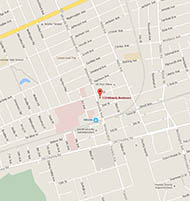Robotic vs Laparoscopic vs Open Surgery
NYU Langone Long Island Surgical Associates is composed of a multidisciplinary team of general surgeons and surgical oncologists that routinely treat complex conditions in and around the abdominal area. Because of the depth of experience in our program, we can offer our patients a number of different treatment options, each with specific benefits and considerations.
One of the most common conversations we have with our patients revolves around the determination of which surgical technique to use. Most of the surgeons here at NYU Langone Long Island Surgical Associates are trained in open surgery, laparoscopic or minimally invasive surgery, and robotically assisted surgical techniques. Having all three options at our disposal gives us a great deal of flexibility when helping patients find the most appropriate treatment.
But, what are the actual differences between these approaches and do they actually matter? Let’s discuss each:
Open Surgery
Open surgery is the traditional technique that surgeons have employed for centuries. Open surgery requires a single or multiple large incisions where the surgeon is able to look directly into the body and see the surgical field. Typically, short-handled instruments are used and the surgeon can manipulate the anatomy directly. Open surgery still has a place in modern medicine, as not all patients and procedures are suited to the minimally invasive approach.
Most patients will be advised that even during laparoscopic surgery unexpected situations may require conversion to an open procedure. Typically, this happens when there’s significant scar tissue in the surgical area, usually from a previous surgery, or when the patient has a significant amount of visceral fat in the area of the surgical field. Both of these conditions reduce visibility from the minimally invasive camera, making an open procedure safer and faster.
On the flipside, due to the size of the incision, there are several considerations that a patient must understand about open surgery. First, the risk of infection, blood loss and pain are all increased, though overall risk still remains low. Recovery takes longer, and the hospital stay is usually extended by one night for most procedures. The large incision also increases the risk of an incisional hernia, as cutting the abdominal muscle and fascia creates a new point of weakness in the abdomen. Only about 1-2% of all our procedures are performed in an open manner.
Traditional Laparoscopy
As recently as a few decades ago, minimally invasive surgery was considered the stuff of science fiction. Today, however, it is the gold standard in most general surgery procedures. By inflating the abdomen with CO2 gas, inserting a tiny high resolution camera, and using long, specially-made medical devices, surgeons can now access the abdomen and perform surgery using only 3 to 4, tiny, ½-inch incisions. This has reduced recovery time and hospital stay, as well as minimized the risks of infection, blood loss and pain associated with the procedure. Further, the risk of hernia is much reduced because the incisions are so small. Cosmetically, results are excellent, with the incisions made during laparoscopic surgery becoming more difficult to see within a year or two after surgery.
On the downside, traditional laparoscopy is not appropriate for all complex surgeries where the dexterity of the human wrist may be needed to ensure a safe and effective procedure. Because of the long and inflexible nature of laparoscopic tools, the number of procedures that could be performed purely laparoscopically is somewhat limited.
Robotically Assisted Surgery
Over the past several years, the advent of robotic surgery has changed the landscape of complex surgical technique. The robot combines the dexterity of open surgery with the minimally invasive nature of traditional laparoscopy. The surgeon controls several robotic arms which have wristed hinges to allow for 360° rotation within the abdomen. This allows the surgeon to perform complex surgeries that would otherwise have required an open approach. Further, the surgeon is comfortably seated next to the operating table, thus reducing fatigue. The camera used in robotic surgery is not only high definition, but also provides a three-dimensional view, giving the surgeon an immersive experience of the surgical field.
Of note, robotic surgery has many of the same benefits of traditional laparoscopy, but typically comes at a higher cost. Further, in the case of a procedure such as a gallbladder removal or cholecystectomy, the robot offers no benefit over traditional laparoscopy and therefore will likely not be used. Lastly, because the technology is somewhat limited in numbers, not all procedures can be performed robotically, as simply a matter of availability.
In today’s surgical landscape, programs that offer the patient a multitude of options for their condition are best positioned to offer an exceptional patient experience. Knowing and acting on this, the team here at with NYU Langone Long Island Surgical Associates is constantly evaluating new and exciting techniques to improve patient outcomes, while maintaining our exceptional safety record. To learn more about the various surgical techniques, please contact our office.





